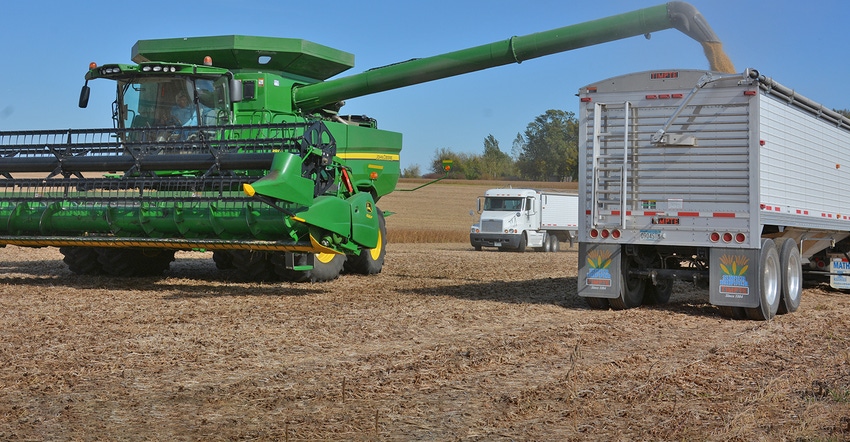
Minnesota historically exports more than $2 billion in soybeans worldwide each year. However, given the escalating trade war between the U.S. and China — the largest importer of Minnesota beans — farmers in the state are extremely worried about markets. And that concern stretches into 2019 spring planting.
One of every three rows of Minnesota soybeans heads for China.
Some growers say they will wait and see how the negotiations play out and make planting decisions next spring. Some are prepared to plant nearly all corn or bump up other crop acreage.
Jamie Beyer of Wheaton, Minn., traditionally plants the same acreage of corn and soybeans annually on her family farm in west-central Minnesota.
As of mid-September, that was still the plan.
“We are not planning to make any changes right now, but will reconsider our crop plans next spring,” Beyer says. Her family grows a variety of crops, including sugarbeets, alfalfa and wheat.
“If we decide to grow less soybeans on our farm, we would consider planting more wheat or more corn,” she says. “Crop options are limited in our area, due to our cool climate and considerable precipitation. Adding another crop to the mix may also require significant equipment purchases and other financial investments.”
Effect next spring
Lawrence Sukalski of Fairmont, Minn., says the current trade situation will affect his crops next spring, assuming Chinese export markets do not recover. A Chinese trade team visited his farm in early September, along with a few other Minnesota soybean operations. He told the visitors that bean prices are so low that he may plant nearly all corn next year. And he would have a ready market for it, too.
“We’re special in Martin County as we have ethanol plants and hogs. Corn is king in this county,” he says.
Jim Kukowski of Strathcona, Minn., thinks his soybean acres could be down next spring, too, if current trade conditions remain the same.
“Soybeans do not cash-flow at this time,” he says. “It will all depend on [customer] need for seed for 2020, the cost of seed that I have to purchase and the futures market.”
Kukowski, of Roseau County, raises soybean and wheat seed for a few seed companies in the region.
“I might have to go back to raising sunflowers, canola or flax — if we can make these crops cash-flow,” he adds.
With his crop rotation, Bob Worth of Lake Benton, Minn., says he needs soybeans in the mix and he is not going to plant corn-on-corn.
“That’s too expensive,” he says. “There’s no profit in any commodity. We’ll go the way we are and hope the administration can work this out.”
The Lincoln County farmer added he is more concerned about how bankers will deal with the impact of depressed crop prices on farmers who will be coming in for the next crop year’s operating loans.
“Cash flows aren’t going to work at $7.25 soybean and $2.90 corn,” he says.
The tariff tit-for-tat has come “at the most terrible time,” Worth adds, on top of already low prices and USDA’s Sept. 12 crop production report of projected record corn and soybean yields for 2019.
“This is a triple whammy and making things extremely ugly,” he says.
Long-term, Worth predicts it will take some time to rebuild trade relationships to the point where China will again buy from the U.S.
Long-term fallout
Other soybean farmers, such as Beyer, also are concerned about the long-term repercussions from the current tariffs and trade disputes.
“Soybean farmers have worked for many years to develop business relationships and market infrastructure for trade with China,” she says. The tariffs put a barrier between farmers and Chinese customers.
Beyer adds she is very worried about the ability of new farmers to enter an industry with unstable markets, and she voiced concern for farmers ready to retire.
“A friend reminded me that it takes five years of farming to make up for one bad year,” she says, “and China’s tariffs exacerbate an already depressed farm economy. With revenue slimmer and prices set by forces outside of our control, farmers also continue to suffer from the excessive costs of healthcare and taxes — just like other U.S. businesses.”
The trade war between the U.S. and China continues to escalate. The Trump administration imposed new 10% tariffs on $200 billion of Chinese goods on Monday. China retaliated with new taxes of 5% to 10% on $60 million of U.S. goods.
According to a Monday news release from the American Soybean Association, the price of U.S. soybeans at export terminals in New Orleans has dropped 20% since June — from $10.89 to $8.68 per bushel. Farm-gate prices have fallen even further.
ASA pointed out that China has pursued new markets to maximize soybean imports from other exporting countries, particularly Brazil.
“With the situation worsening, these decisions could become long-term policies,” says David Stephens, a Kentucky soybean grower and ASA vice president. “Even if the administration achieves its goal of changing China’s policies on forced technology transfer and intellectual property theft, which could end the tariff war, this trend could be irreversible. U.S. soybean farmers may become the supplier of last resort to what has been, by far, our most important foreign market.”
According to ASA, some trade analysts say it will be impossible for China to find enough soybeans and other protein feeds from other sources, and that it will continue to depend on the U.S. for a significant amount of its imports. However, even if the U.S. keeps half of its soybean market in China, ASA says the value of exports due to lower prices will fall to an estimated $5.6 billion from the $14 billion sold in 2017.
In the absence of other expanded and new markets, ASA said the outlook is for continued low prices and declining U.S. soybean production for years to come.
About the Author(s)
You May Also Like






